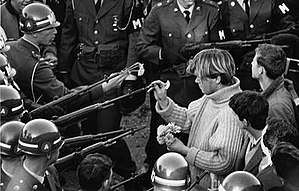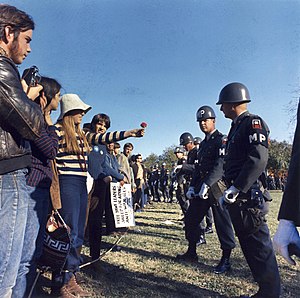Flower Power (photograph)
Flower Power is a photograph taken by American photographer Bernie Boston for the now-defunct newspaper The Washington Star. Taken on October 21, 1967, during the National Mobilization Committee to End the War in Vietnam's "March on The Pentagon", the photo shows a Vietnam War protester placing a carnation into the barrel of an M14 rifle held by a soldier of the 503rd Military Police Battalion.[1]

It was nominated for the 1967 Pulitzer Prize.[2]
Events
The National Mobilization Committee to End the War in Vietnam's "March on The Pentagon" took place on October 21, 1967. When the antiwar demonstrators approached The Pentagon, they were confronted by a squad of soldiers from the 503rd Military Police Battalion. The soldiers pointed their rifles, marched into the crowd and formed a semicircle around the demonstrators to prevent them from climbing the Pentagon steps. Washington Star newspaper photographer Bernie Boston had been assigned by his editor to cover the demonstration. Boston was sitting on a wall at the Mall Entrance which allowed him to see the events unfold.[3] In a 2005 interview he said, "When I saw the sea of demonstrators, I knew something had to happen. I saw the troops march down into the sea of people and I was ready for it."[4] A young man emerged from the crowd of demonstrators and started placing carnations into the barrels of their rifles.[3] Boston captured the moment in what would become an iconic image and his signature photograph.[3]
When Boston showed the photograph to his editor at The Washington Star, "the editor didn't see the importance" and the picture was run on a page deep inside the newspaper.[3] It was after Boston entered it into photography competitions, which it won, that it gained recognition.[3]
Identity of the demonstrator

The young man in the photo is most commonly identified as George Edgerly Harris III, an 18-year-old actor from New York who moved to San Francisco in 1967.[1][5] Harris performed under the stage name of Hibiscus and co-founded The Cockettes, a "flamboyant, psychedelic gay-themed drag troupe."[1] Harris died in the early 1980s during the beginning of the HIV/AIDS epidemic.[1]
Paul Krassner, in a 2008 article in the Huffington Post, said the young man in the photo was Joel "Super-Joel" Tornabene, a counter-culture leader of the Youth International Party who lived in Berkeley, California in the 1960s.[6] Tornabene died in Mexico in 1993.[7]
Symbolic significance

The Flower power movement began in Berkeley, California as a means of symbolic protest against the Vietnam War. Beat Generation writer Allen Ginsberg, in his November 1965 essay How to Make a March/Spectacle, promoted the use of "masses of flowers" to hand to policemen, press, politicians and spectators to civilly fight violence with peace.
The use of nonviolent objects such as toys, flags, candy and music were intended to show that the movement was not associated with anger or violence. Members of the movement even went as far as trying to negate the rallies of the Hells Angels motorcycle gang who supported the war.
Critical and cultural recognition
Flower Power was nominated for the 1967 Pulitzer Prize.[2]
It had an influential effect on both the antiwar movement of the sixties, and as a visual representation of how photojournalism can help with a movement.[8]
Specific exhibits and discussions have been curated solely around the photograph to display the political, cultural and social aspects of the Flower power movement. The exhibit From Kennedy to Kent State: Images of a Generation, was shown at Worcester Art Museum in Worcester, Massachusetts, which displayed Boston's image as a large gelatin silver print. The image was included as a representation of the antiwar movement.[9]
In 1993, the National Press Photographers Association presented Boston with its highest honor, the Joseph A. Sprague Memorial Award—"the honor recognizes a working photojournalist who advances, elevates, or attains unusual recognition for the profession by their conduct, initiative, leadership, skill, and devotion to duty." [10]
Flower Power continues to be used as an iconic image of the 1960s.[11]
See also
- The Ultimate Confrontation, a similar photograph taken by Marc Riboud the same day
References
- "Flowers, Guns and an Iconic Snapshot". Washingtonpost.com. March 18, 2007. Retrieved December 6, 2013.
- Boston, Bernie (October 21, 1967). "Flower Power". The Washington Evening Star.
- Stewart, Jocelyn Y. (January 25, 2008). "Bernie Boston; captured iconic 60s' moment - The Boston Globe". Boston.com. Retrieved December 6, 2013.
- Ashe, Alice (2005). "Bernie Boston: View Finder" (PDF). Curio Magazine. James Madison University. Archived from the original on September 20, 2009. Retrieved September 29, 2017.CS1 maint: BOT: original-url status unknown (link)
- Silva, Hoaracio (August 17, 2003). "Karma Chameleon". New York Times Magazine. New York Times Company. Retrieved 9 October 2017.
- Krassner, Paul (January 30, 2008). "Tom Waits Meets Super-Joel". The Huffington Post. Retrieved 2011-01-24.
- Krassner, Paul (November 30, 2009). "A Dose of My Own Medicine". Antique Children. AQC Books.
- Gottschalk, Molly (2016-07-12). "Why certain photographs quickly come to define a movement". Artsy. Retrieved 2020-04-19.
- "Kennedy to Kent State: Images of a Generation". Worcester Art Museum. October 22, 1967. Retrieved December 6, 2013.
- "Joseph A Sprague Memorial Award". NPPA. Retrieved December 6, 2013.
- Mulligan, Therese. Bernie Boston: American Photojournalist. ISBN 9781933360195.